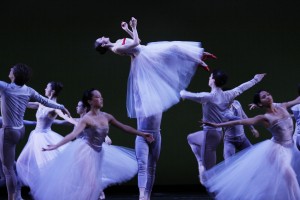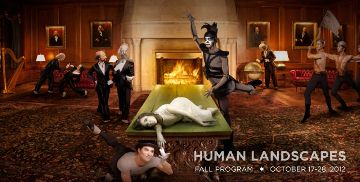THE LANDSCAPE OF THE SOUL
Those who were lucky enough to witness the Joffrey Ballet’s Spring Desire program this year were treated to what may well have been the greatest dance program in years. The Joffrey has reached a pinnacle of form, beauty, and transplendent theatricality that other dance companies—indeed, most theater events—should strive for.
Now, with their fall program, The Joffrey Ballet celebrates the 80th anniversary of The Green Table, the seminal anti-war ballet by the late German Expressionist Kurt Jooss. As Joffrey is unquestionably among the world’s greatest dance companies, the upcoming Human Landscapes is promising to be one of the not-to-miss events of the year. The Green Table, a ground-breaking 20th century masterpiece, will be presented along with James Kudelka’s Pretty BALLET and Jiøí Kylián’s Forgotten Land. The outstanding mixed repertory program will play at Chicago’s Auditorium Theatre, October 17-28, 2012.
 James Kudelka’s Pretty BALLET returns to the stage after the Joffrey presented its World Premiere in 2010. Set to Bohuslav Martinù’s Symphony No. 2, Kudelka’s four-movement work uses demanding movement phrases full of quick, sharp changes of direction, along with intricate spatial patterns and a haunting adagio pas de deux with a ballerina in blood-red pointe shoes, all to explore the subject of ballet itself as a balance between romantic ideals and industrious principles. Kudelka is widely acknowledged as one of North America’s most innovative choreographers. His mastery of both classical ballet and modern/contemporary dance has earned him commissions from companies—over 20 in all—as stylistically diverse as American Ballet Theatre, Hubbard Street Dance and Les Ballets Jazz de Montréal.
James Kudelka’s Pretty BALLET returns to the stage after the Joffrey presented its World Premiere in 2010. Set to Bohuslav Martinù’s Symphony No. 2, Kudelka’s four-movement work uses demanding movement phrases full of quick, sharp changes of direction, along with intricate spatial patterns and a haunting adagio pas de deux with a ballerina in blood-red pointe shoes, all to explore the subject of ballet itself as a balance between romantic ideals and industrious principles. Kudelka is widely acknowledged as one of North America’s most innovative choreographers. His mastery of both classical ballet and modern/contemporary dance has earned him commissions from companies—over 20 in all—as stylistically diverse as American Ballet Theatre, Hubbard Street Dance and Les Ballets Jazz de Montréal.
Also on the program will be Jiøí Kylián’s 1981 work Forgotten Land, not performed by the Joffrey since its Company Premiere in 1985. With music by Benjamin Britten (2013 will be the 100th anniversary of Britten’s birth) and inspired by a painting of women on a beach by Edvard Munch, this dance uses a motif of pulsing, circular movements reminiscent of waves to invoke treasured memories of lost homelands, lost lovers and lost time. Kylián, now retired as the Artistic Director of the Nederlands Dans Theater (NDT) in Den Haag, Netherlands, made a successful debut with Viewers (1973), the first of more than 60 choreographies he was to develop specifically for the NDT, with whom he maintains the essential roles of Resident Choreographer and Artistic Adviser.
 Fabrice Calmels and Dylan Gutierrez will share the role of Death in Kurt Jooss’ The Green Table, an international dance classic originally choreographed in 1932; it is a pure example of both Jooss’ individual style and of German Expressionist dance. The Joffrey Ballet was the first American company to dance The Green Table, a Company Premiere in 1967. Subtitled “A Dance of Death in Eight Scenes” and set to music by Frederick A. Cohen, The Green Table is a commentary on the futility of war and the horrors it causes. It opens with a group of diplomats (the “Gentlemen in Black”) having a discussion around a rectangular table covered with a green cloth. They end up pulling guns from their pockets and shooting in the air, thus symbolizing the declaration of war. The next six scenes portray different aspects of wartime: The separation from loved ones in The Farewells, war itself in The Battle and The Partisan, loneliness and misery in The Refugees, the emotional void and forced entertainment in The Brothel, and, finally, the psychologically beaten and wounded survivors in The Aftermath. The ballet then ends as it began, with the “Gentlemen in Black” around the green table. Throughout these episodes the figure of “Death” is triumphant, portrayed as a skeleton moving in a forceful and robotic way, relentlessly claiming its victims.
Fabrice Calmels and Dylan Gutierrez will share the role of Death in Kurt Jooss’ The Green Table, an international dance classic originally choreographed in 1932; it is a pure example of both Jooss’ individual style and of German Expressionist dance. The Joffrey Ballet was the first American company to dance The Green Table, a Company Premiere in 1967. Subtitled “A Dance of Death in Eight Scenes” and set to music by Frederick A. Cohen, The Green Table is a commentary on the futility of war and the horrors it causes. It opens with a group of diplomats (the “Gentlemen in Black”) having a discussion around a rectangular table covered with a green cloth. They end up pulling guns from their pockets and shooting in the air, thus symbolizing the declaration of war. The next six scenes portray different aspects of wartime: The separation from loved ones in The Farewells, war itself in The Battle and The Partisan, loneliness and misery in The Refugees, the emotional void and forced entertainment in The Brothel, and, finally, the psychologically beaten and wounded survivors in The Aftermath. The ballet then ends as it began, with the “Gentlemen in Black” around the green table. Throughout these episodes the figure of “Death” is triumphant, portrayed as a skeleton moving in a forceful and robotic way, relentlessly claiming its victims.
“The artists whose work we present this season hold a special place in Joffrey history,” noted Ashley Wheater, Joffrey Ballet Artistic Director. “Not only is The Green Table recognized as one of the most important works of German Expressionism, it was the first ballet Robert Joffrey saw as an audience member when he was 11 years old. The impact of that experience prompted him to restage the ballet with the Joffrey in 1967. In the 1980’s, Robert Joffrey was a champion of the choreography of Jiøí Kylián and James Kudelka, artists who were not well known to American audiences. Their works have been part of our repertoire ever since.”
To better understand the man whose name graces this inestimable company, watch the superb documentary Joffrey: Mavericks of American Dance. To better understand the vision that Joffrey stood for, and to support that vision for the future, attend Human Landscapes.
Human Landscapes
The Joffrey Ballet at the Auditorium Theatre of Roosevelt University
through October 28, 2012
for tickets, call (800) 982-2787 or visit http://www.ticketmaster.com
for more info about The Joffrey Ballet and its programs visit http://www.joffrey.org

